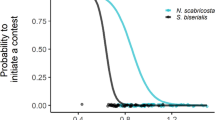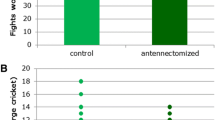Summary
I tested the prediction derived from game theory models that the intensity of aggressive interactions should reflect the value of the resource being contested and the disparity in fighting ability of the contestants. Females of the yellow-rumped cacique compete for nest sites and the material to build nests. Females competing for established nest sites engage in higher intensity interactions than those competing for sites in which building has not begun and against females robbing nest material (Fig. 1). For males, access to females is determined by dominance, which is positively correlated with weight. Comparably-sized males (Fig. 2) and those of similar rank (Fig. 3) engage in significantly more intense interactions than males that differ widely in size or rank.
Similar content being viewed by others
References
Balph MH, Balph DF, Romesburg HC (1979) Social status signaling in winter flocking birds: an examination of a current hypothesis. Auk 96:78–93
Clutton-Brock TH, Albon SD (1979) The roaring of red deer and the evolution of honest advertisement. Behaviour 69:145–170
Feekes F (1981) Biology and colonial organization of two sympatric caciques, Cacicus c. cela and Cacicus h. haemorrhous (Icteridae: Aves) in Surinam. Ardea 69:83–107
Frey DF, Miller RJ (1972) The establishment of dominance relationships in the blue gourami Trichogaster trichopterus (Pallas). Behaviour 42:8–62
Hammerstein P (1981) The role of asymmetries in animal contests. Anim Behav 29:193–205
Henderson DC, Chiszar DA (1977) Analysis of aggressive behaviour in the bluegill sunfish (Lepomis macrochirus Rafinesque): Effects of sex and size. Anim Behav 25:122–130
Ketterson ED (1979) Status signaling in dark-eyed juncos. Auk 96:94–99
Maynard Smith J, Parker GA (1976) The logic of asymmetric contests. Anim Behav 24:159–175
Otronen M (1984) Male contests for territories and females in the fly Dryomyza anilis. Anim Behav 32:891–898
Parker GA (1974) Assessment strategy and the evolution of fighting behavior. J Theor Biol 47:223–243
Parker GA, Rubenstein DI (1981) Role assessment, reserve strategy, and acquisition of information in asymmetric animal conflicts. Anim Behav 29:221–240
Petrie M (1984) Territory size in the moorhen (Gallinula chloropus): an outcome of RHP asymmetry between neighbours. Anim Behav 32:861–870
Rand AS, Rand WM (1976) Agonistic behaviour in nesting Iguanas: A stochastic analysis of dispute settlement dominated by the minimization of energetic costs. Z Tierpsychol 40:279–299
Riechert SE (1978) Games spiders play: Behavioral variability in territorial disputes. Behav Ecol Sociobiol 3:135–162
Riechert SE (1979) Games spiders play II: Resource assessment strategies. Behav Ecol Sociobiol 6:121–128
Riechert SE (1984) Games spiders play III: Cues underlying context-associated changes in agonistic behaviour. Anim Behav 32:1–15
Robinson SK (1984) Social behavior and sexual selection in a neotropical oriole. PhD thesis, Princeton University, Princeton, NJ
Robinson SK (1985a) (in press) Coloniality as a defense against nest predators of the Yellow-rumped Cacique. Auk 102
Robinson SK (1985b) (in press) The benefits, costs and determinants of dominance in a neotropical oriole. Anim Behav 33
Robinson SK (1985c) The yellow-rumped cacique and its associated nest pirates. In: Buckley PA, Foster MS, Morton ES, Ridgely RS, Buckley FG (eds) Neotropical ornithology. Ornithological Monograph, vol. 36. American Ornithological Union, Washington, DC, pp 898–907
Robinson SK (1985d) (in press) Competitive and mutualistic interactions between females of a neotropical oriole. Anim Behav 33
Rubenstein DI (1981) Combat and communication in the Everglades pygmy sunfish. Anim Behav 29:249–258
Sigurjonsdottir H, Parker GA (1981) Dung fly struggles: Evidence for assessment strategy. Behav Ecol Sociobiol 8:219–230
Sinclair ME (1977) Agonistic behaviour of the stone crab, Menippe mercenaria (Say). Anim Behav 25:193–207
Terborgh JW (1983) Five new world primates: a study in comparative ecology. Monographs in behavior and ecology, vol 1 Princeton University Press, Princeton, NJ
Thornhill R (1984) Fighting and assessment in Harpobittacus scorpionflies. Evol 38:204–214
Yasukawa K, Bick EI (1983) Dominance hierarchies in darkeyed juncos (Junco hyemalis): a test of a game-theory model. Anim Behav 31:439–448
Author information
Authors and Affiliations
Rights and permissions
About this article
Cite this article
Robinson, S.K. Fighting and assessment in the yellow-rumped cacique (Cacicus cela). Behav Ecol Sociobiol 18, 39–44 (1985). https://doi.org/10.1007/BF00299236
Received:
Accepted:
Issue Date:
DOI: https://doi.org/10.1007/BF00299236




